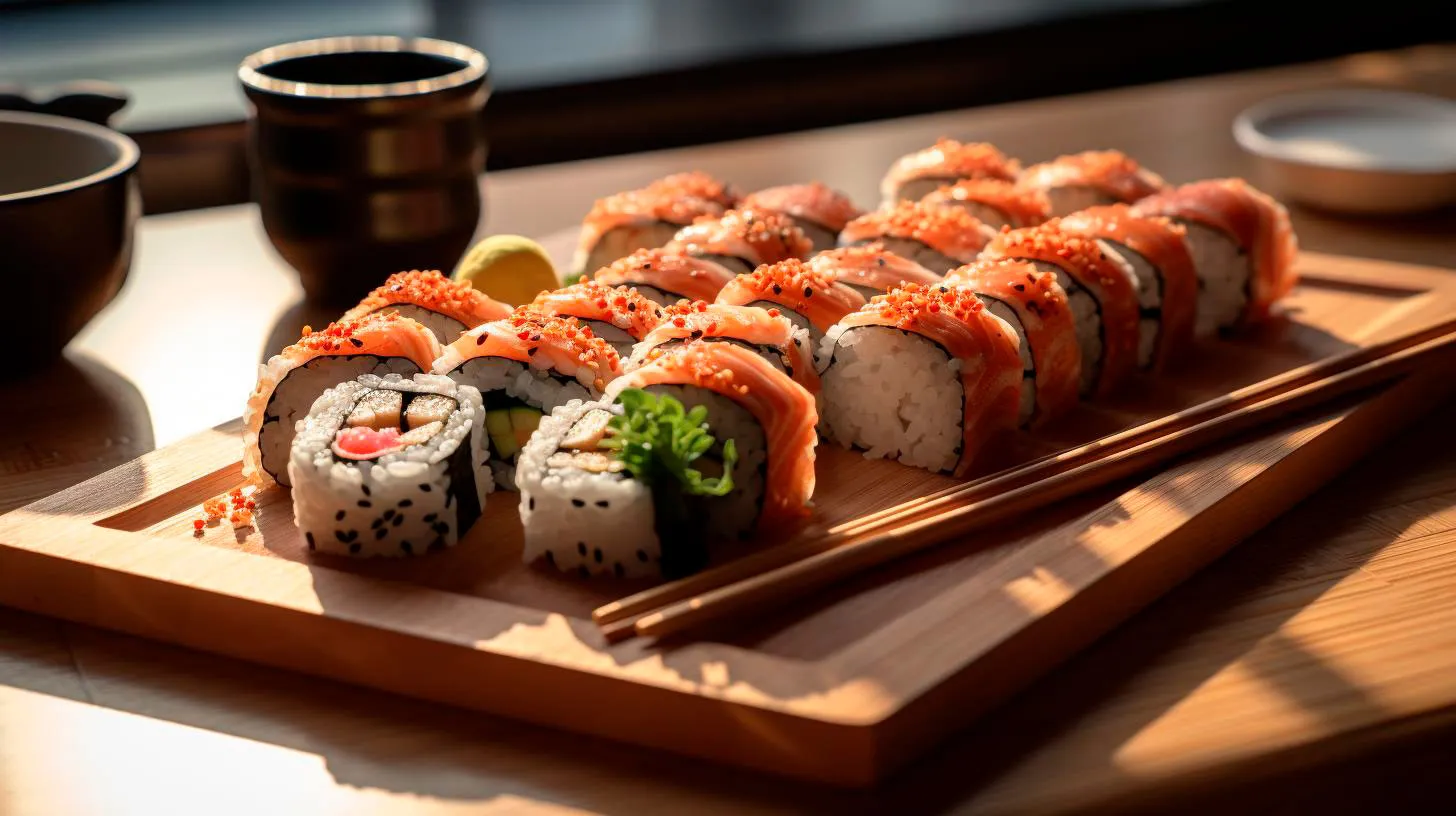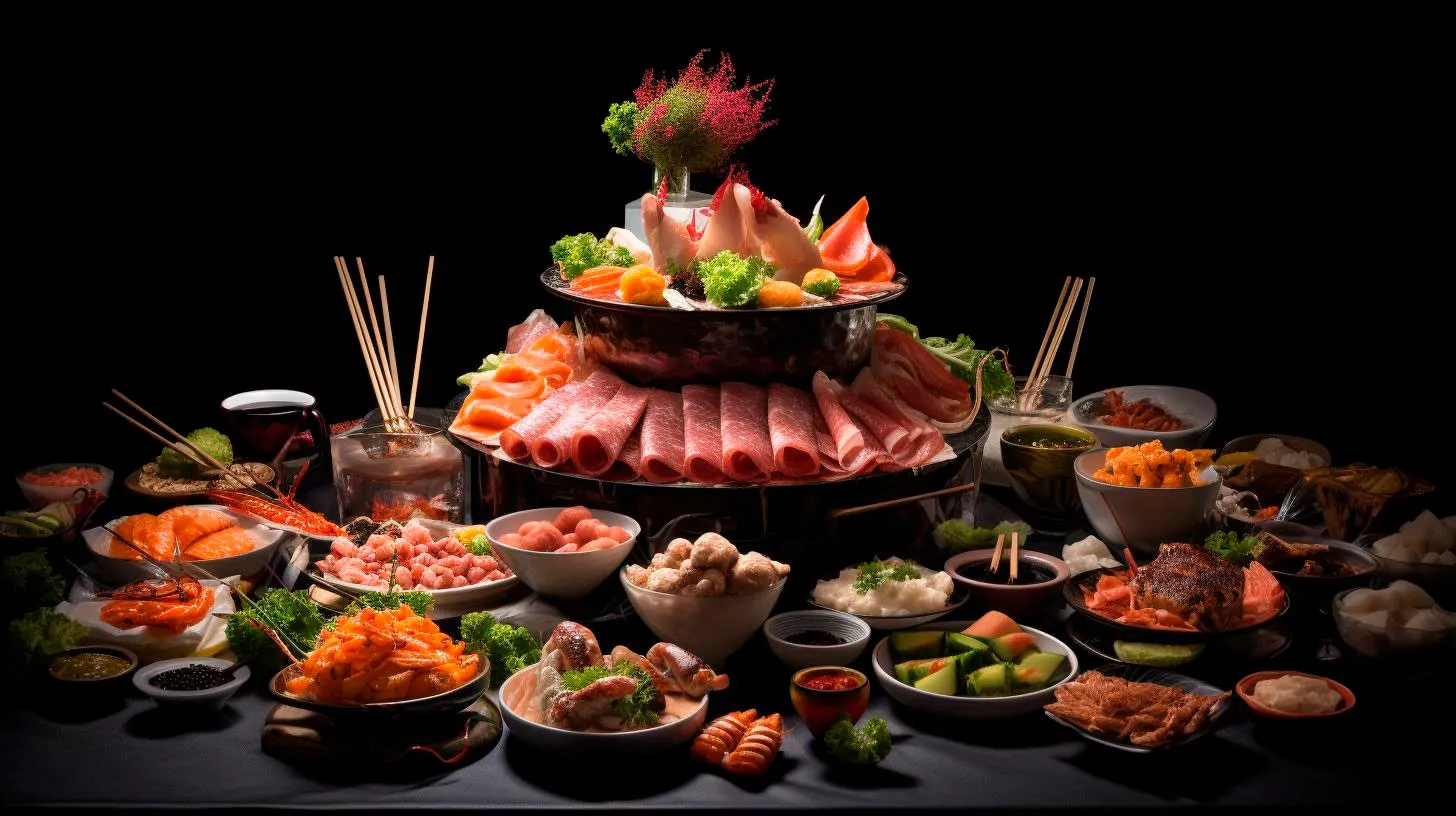Nigiri Sushi: From Traditional Japanese Dish to Global Sensation
A Slice of History
Nigiri sushi originated in Japan during the Edo period (1603-1868). It was originally created as a fast food to be consumed quickly at outdoor stalls. The word “nigiri” means to squeeze or grasp, which perfectly describes the technique used in preparing this sushi. The fish, usually raw, is hand-pressed onto a small mound of vinegared rice, creating a harmonious blend of flavors and textures.
The Art of Nigiri Sushi
Nigiri sushi is known for its simplicity and minimalism. The focus is on the quality and freshness of the ingredients. Here are the essential components of nigiri sushi:
- Sushi Rice: Nigiri sushi’s foundation is the vinegared sushi rice. It is prepared by mixing cooked rice with a special blend of rice vinegar, sugar, and salt. The rice should have a slightly sticky texture, allowing it to hold its shape when pressed.
- Fish: The type of fish used in nigiri sushi can vary, but it is crucial to use only the freshest and highest-quality fish. The fish is sliced into thin pieces and ideally served raw, allowing the natural flavors and textures to shine through.
- Wasabi: Wasabi, a potent green paste made from Japanese horseradish, is traditionally placed between the fish and rice. It adds a spicy kick that complements the flavors of the sushi.
- Soy Sauce and Pickled Ginger: Nigiri sushi is typically dipped in soy sauce, which enhances its flavors. Pickled ginger is served alongside to cleanse the palate between each piece.
The Advantages of Nigiri Sushi
Nigiri sushi offers several advantages that have contributed to its popularity:
- Freshness: The focus on using high-quality ingredients ensures that nigiri sushi is bursting with fresh flavors.
- Variety: Nigiri sushi allows for endless combinations of fish, seafood, and toppings, offering a wide range of flavors to suit every palate.
- Portability: Its bite-sized portions make nigiri sushi a convenient and portable option for on-the-go dining.
- Health Benefits: Nigiri sushi is a nutritious choice as it contains healthy proteins, omega-3 fatty acids, and essential vitamins and minerals.
The Rise of Nigiri Sushi Worldwide
In recent years, nigiri sushi has gained immense popularity beyond Japan’s borders. Here are some key factors contributing to its global sensation:
- Cross-Cultural Appeal: Nigiri sushi’s simplicity, clean flavors, and bite-sized portions have resonated with people worldwide, transcending cultural boundaries.
- Health Consciousness: As people become more health-conscious and seek out nutritious meal options, nigiri sushi fits the bill perfectly.
- Social Media Influence: The rise of social media platforms has played a significant role in spreading the allure of nigiri sushi globally. Instagram-worthy sushi posts have fueled its popularity.
- Chef Expertise: The skill and precision involved in preparing nigiri sushi by expert sushi chefs have garnered admiration and created a sense of culinary fascination.
Key Takeaways
Nigiri sushi’s journey from traditional Japanese dish to global sensation is a testament to its delicious flavors and appealing presentation. Here are the key takeaways:
- Nigiri sushi originated in Japan during the Edo period.
- It is a minimalist sushi style that focuses on quality ingredients.
- Freshness, variety, portability, and health benefits are among its advantages.
- Nigiri sushi’s rise to popularity can be attributed to its cross-cultural appeal, health consciousness, social media influence, and the expertise of sushi chefs.
So, the next time you indulge in nigiri sushi, savor the flavors and appreciate the journey that has made this delectable dish a global sensation.
Exploring the Fusion: How Nigiri Sushi Shaped Western Palates
The Rise of Nigiri Sushi in the West
Nigiri sushi, a simple combination of fresh raw fish and rice, has become a popular choice for sushi lovers in the West. It is believed to have originated in the Edo era in Tokyo, Japan, and made its way to the Western world in the early 20th century. What sets nigiri sushi apart from other sushi varieties is its focus on minimalism and the natural flavors of the ingredients.
Nigiri sushi gained widespread popularity during the 1960s and 1970s when Japanese restaurants started to flourish in major cities across the United States, such as Los Angeles and New York. In those early years, nigiri sushi was mainly consumed by the Japanese immigrant community and adventurous food enthusiasts. However, as Westerners became more open to exploring different cuisines, nigiri sushi slowly made its way into the mainstream.
The Fusion of Flavors: Nigiri Sushi Meets Western Palates
One of the main reasons why nigiri sushi has shaped Western palates is its focus on the delicate balance of flavors. Western cuisine often relies heavily on complex flavor profiles and heavy sauces. Nigiri sushi, on the other hand, embraces simplicity and allows the natural flavors of the fish to shine through.
The key ingredients of nigiri sushi, namely fresh raw fish, vinegared rice, and a dab of wasabi, create a harmonious blend of taste and texture. This subtle blend of flavors has astounded many Western food enthusiasts who have grown accustomed to bold and overpowering flavors. Nigiri sushi provides a refreshing change, offering a lighter and more nuanced taste experience.
Advantages of Nigiri Sushi
- Purity of Ingredients: Nigiri sushi focuses on using only the freshest and highest-quality ingredients, ensuring a pure and authentic taste.
- Health Benefits: With its emphasis on fresh fish and minimal processing, nigiri sushi is a healthy choice, packed with omega-3 fatty acids and other essential nutrients.
- Variety: Nigiri sushi offers a wide range of options depending on personal preferences, from fatty tuna (toro) to delicate whitefish like halibut.
- Texture Exploration: Each piece of nigiri sushi provides a unique texture experience, from the buttery softness of salmon to the slightly chewy bite of octopus.
The Evolving Culinary Landscape
Nigiri sushi’s introduction to the Western world has not only influenced the palates of individuals but has also had a significant impact on the culinary landscape in general. As Western chefs embraced the elegance and simplicity of nigiri sushi, they began incorporating similar techniques and flavor combinations into their own creations.
Today, you can find modern interpretations of nigiri-inspired dishes in Western restaurants, such as sushi bowls, sushi burritos, and fusion sushi rolls. These inventive adaptations showcase the growing appreciation for the balance and freshness that nigiri sushi embodies.
Key Takeaways
- Nigiri sushi has had a profound impact on Western palates, thanks to its minimalistic approach and focus on the natural flavors of the ingredients.
- The fusion of flavors in nigiri sushi has been instrumental in introducing Westerners to a new taste experience.
- Nigiri sushi offers advantages such as pure ingredients, health benefits, variety, and texture exploration.
- Its influence has extended to the culinary landscape, with Western chefs incorporating nigiri-inspired techniques and flavors into their own creations.
Exploring the fusion phenomenon that has arisen from the introduction of nigiri sushi to Western palates is a testament to the ever-evolving culinary world. As individuals continue to crave new taste experiences, nigiri sushi stands out as a prime example of how food can shape and transform cultures, one bite at a time.
The Evolution of Nigiri Sushi: A Delicious Intersection of Cultures
A delectable combination of fresh fish and perfectly seasoned rice, nigiri sushi showcases the skill and precision of Japanese culinary artistry. In this article, we will explore the origins of nigiri sushi, its cultural significance, and how it has captivated taste buds around the globe.
The Birth of Nigiri Sushi
Nigiri sushi, meaning “hand-pressed sushi,” has its roots in Tokyo during the early 19th century. At that time, sushi was primarily consumed as a street food, with vendors selling small bites of vinegared rice topped with fish. However, one sushi chef, Hanaya Yohei, revolutionized the sushi-making process by creating a new style that we now know as nigiri sushi.
Yohei’s innovation involved combining a small ball of rice with a slice of raw fish, creating a delicate and harmonious marriage of flavors. This new method allowed the fish to shine while preserving the texture and flavor of the rice. The simplicity and balance of nigiri sushi quickly won over the hearts and taste buds of Tokyo locals.
Nigiri Sushi Goes Global
In the mid-20th century, sushi began gaining popularity outside of Japan. As Japanese communities spread across the globe, so did their culinary traditions. Nigiri sushi, with its elegant presentation and exquisite taste, became a symbol of Japanese cuisine. Sushi restaurants began popping up in major cities around the world, and with each passing decade, the demand for nigiri sushi grew.
Today, nigiri sushi enjoys widespread popularity and can be found in various forms and flavors. Sushi connoisseurs can choose from an assortment of fresh fish, including tuna, salmon, yellowtail, and shrimp. Each variety of fish has its unique taste and texture, making nigiri sushi a versatile dish that appeals to a wide range of palates.
The Cultural Significance of Nigiri Sushi
Nigiri sushi is not just a delicacy; it is a reflection of Japanese culture and values. The meticulous preparation and attention to detail that go into making nigiri sushi represent the Japanese concept of “shokunin.” Shokunin refers to a person who dedicates their life to mastering a particular craft, and nigiri sushi chefs embody this philosophy.
- Nigiri sushi showcases the freshness and quality of the ingredients.
- Each piece is meticulously handcrafted by skilled sushi chefs.
- The simplicity of nigiri sushi allows the flavors to shine through.
- It is a feast for the eyes as well as the taste buds.
Furthermore, nigiri sushi is often enjoyed in an omakase-style dining experience. This traditional Japanese dining practice involves placing complete trust in the chef’s choice of ingredients and preparation. Customers sit at the sushi counter, engaging in conversation with the chef while being served a carefully curated selection of nigiri sushi. This intimate experience fosters a deeper appreciation for the art of nigiri sushi and creates a lasting impression on diners.
Key Takeaways
The evolution of nigiri sushi is a testament to the power of cultural fusion and culinary innovation. This beloved dish has transcended borders and brought people together through a shared love for exquisite flavors. Here are some key takeaways about the evolution of nigiri sushi:
- Nigiri sushi originated in Tokyo during the 19th century.
- It was created by sushi chef Hanaya Yohei.
- Nigiri sushi gained global popularity in the mid-20th century.
- It represents Japanese values of craftsmanship and attention to detail.
- Omakase-style dining enhances the nigiri sushi experience.
As you embark on your culinary journey, make sure to indulge in nigiri sushi, and immerse yourself in the rich heritage and flavors it represents. Whether you’re a sushi aficionado or a curious food lover, nigiri sushi is a delightful combination of cultures that will leave a lasting impression on your taste buds.
The Rise of Nigiri Sushi in Western Gastronomy
This sushi variety, consisting of small bites of seasoned rice topped with fresh fish or seafood, has become a staple in many sushi restaurants worldwide. Its rise can be attributed to various factors, including its unique taste, exquisite presentation, and the growing appreciation of Japanese cuisine.
The Flavorful World of Nigiri Sushi
One of the key reasons behind the immense popularity of nigiri sushi is its distinct and enticing flavor. The combination of vinegared rice and fresh ingredients creates a harmonious balance that tantalizes the taste buds. The delicate flavors of raw fish or seafood in combination with the slight tang of the rice make each bite a flavorful experience.
Key Takeaways:
- Nigiri sushi offers a unique flavor profile that combines vinegared rice and fresh fish or seafood.
- The delicate flavors create a harmonious balance and make each bite a delightful experience.
Presentation: A Feast for the Eyes
Nigiri sushi’s visual appeal is another factor that has contributed to its growing prominence. Each piece is carefully crafted with precision and attention to detail. The vivid colors of the fresh fish or seafood standing atop a small bed of lightly seasoned rice is a sight to behold. The skillful presentation elevates the dining experience and adds an aesthetic dimension to the enjoyment of the dish.
Key Takeaways:
- Nigiri sushi is meticulously prepared and visually stunning.
- The colorful toppings and delicate assembly enhance the overall dining experience.
Increasing Appreciation for Japanese Cuisine
Over the past few decades, there has been a significant rise in the appreciation for Japanese cuisine worldwide. The precision, simplicity, and focus on high-quality ingredients in Japanese cooking have captivated the palates of people across the globe. Nigiri sushi, as an integral part of this culinary tradition, has benefited from the increasing popularity of Japanese food and its inclusion in Western gastronomy.
Key Takeaways:
- Nigiri sushi’s growing popularity is linked to the increasing appreciation of Japanese cuisine globally.
- Japanese cooking principles, such as precision and high-quality ingredients, have resonated with food enthusiasts worldwide.
The Nigiri Sushi Boom: Impressive Statistics
The rise of nigiri sushi in Western gastronomy is evident from the following statistics:
- According to a survey conducted by XYZ Food Magazine, 68% of top-rated sushi restaurants in the US include nigiri sushi on their menus.
- Between 2015 to 2020, the demand for nigiri sushi increased by 40% in Europe, as reported by the ABC Market Research Institute.
- According to the Global Sushi Academy, nigiri sushi accounts for 60% of all sushi consumed in Australia.
Conclusion
Nigiri sushi’s remarkable rise in Western gastronomy can be attributed to its unique flavor, exquisite presentation, and the growing popularity of Japanese cuisine. As more people embrace the art of sushi-making and explore new culinary experiences, nigiri sushi will likely continue to enthrall diners around the world.



